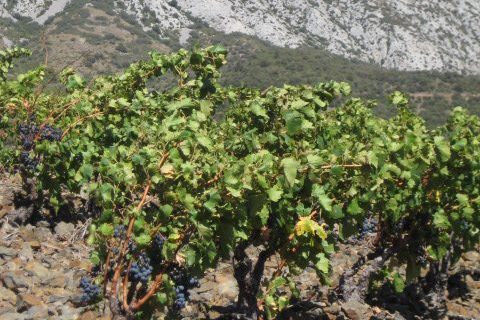| The Languedoc has always had something of a love hate relationship with Carignan. For some it is ‘the emblematic grape variety of the south’, but for others it was Carignan, along with Alicante Bouschet and Aramon, that was responsible for the bad image of the south. But now Carignan is enjoying a distinct revival in its fortunes. As Katie Jones from Domaine Jones in Tuchan so aptly put it: ‘The bad boy of the Languedoc has come good.’ For the wine growers who do produce Carignan, it is a fantastic grape variety, with a strong personality and qualities that make it so suitable for the sometimes-challenging conditions of the Languedoc. Peter Core, who has a high proportion of Carignan in his vineyards at Mas Gabriel in Caux, explained how well Carignan copes with the harsh, dry climate. He says: ‘It is a late ripening grape and it retains freshness and acidity in a way that Syrah often does not. It is less sensitive to disease and the vines age very much better.’ The label Vieilles Vignes, or ‘old vines’, is significant in the discussion about Carignan. Many wine growers have vines that were planted at the beginning of the last century. However, much as old vines are appreciated, there are as yet no rules determining what constitutes an old vine; the only guarantee is the name and reputation of the wine grower. Some argue that the vines need to be very old, 60 or 70 years, to produce good results; others think that is not so. There is a group of fervent Carignan campaigners and enthusiasts, calling itself ‘Carignan Renaissance’, which numbers about 50 members. Jon Bojanowski in St Jean de Minervois is one of its most vocal exponents, producing a pure Carignan, Lo Vièhl, Côtes de Brian. He reckons that there are now about 250 Carignan cuvées produced in Languedoc-Roussillon each year, as opposed to about 25, 15 years ago. Amongst other activities, the group organizes an annual Carignan Day, on the third Thursday of October. Bruno Peyre of Clos des Clapisses is also convinced that the future for Carignan is rosy. ‘More and more wine growers and négociants will begin to produce pure Carignan as the flavour is good, and it is so suitable for the conditions of the south, particularly with its resistance to drought, and especially in the context of the growing concern with global warming.’ As Jean-Claude Mas of Domaines Paul Mas put it: ‘It is the grape variety that people identify with the Languedoc. We must talk about it to reinforce the sense of our roots and our history, as it is so well adapted to our soil and climate and is an intrinsic part of the viticultural diversity of our region’. The Languedoc does not usually identify with one specific grape variety; blends or assemblages are usually the key to the region, but if the Languedoc were to have what he called ‘un vin identitaire’, it would be Carignan. | ||
| AUTHOR Rosemary George was one of the first women to become a Master of Wine, back in 1979. She is the author of 11 books, including The Wines of the Languedoc and The Wines of Chablis and the Grand Auxerrois. Her other specialist wine regions are Tuscany and New Zeland. |
FACT FILE LanguedocGeography: Large vineyard area lies on the Mediterranean coast. The region has Mediterranean climate with lots of sunshine, warm summer, mild winter and low, annual rainfall. Tramontanen (northern wind) brings cool air from the mountains. Grape varieties: Carignan, Syrah, Grenache, Mourvèdre, Cinsault, Cabernet Sauvignon, Chardonnay, Sauvingon Blanc, Viognier, Grenache Blanc, Bourboulenc, Clairette, Picpoul, Vermentino Viticulture: Drought is an issue. Bush vines are still common, but the new international varieties are often trained on wires. Winemaking: The quality of the wines has improved significantly for the last twenty years. Large amount are still made in co-operatives but there are increasing number of small producers. Appellations: Languedoc AOC, Fitou, Corbières, Limoux, Minervois, St-Chinian, Faugères, Picpoul de Pinet |
The Revival of Carignan




